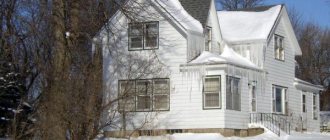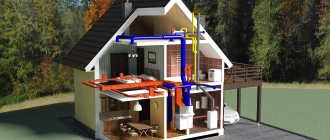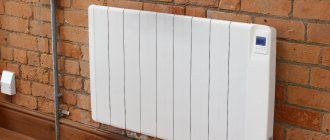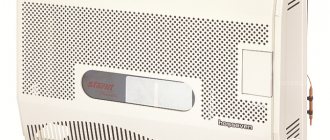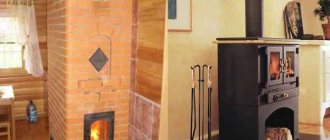Humanity has always been in search of cheap energy and our time is no exception, but for now we have to be content with what we have. Therefore, in places where there are no centralized lines, residents are looking for how to connect a gas boiler to a propane cylinder. Most often, for them this will be the most optimal option for solving the problem of heating a country house or cottage.
Connection diagram of an LPG boiler to a heating system Source strojdvor.ru
But, before buying a boiler and cylinders, it would not hurt to understand how such heating systems work and what will be most practical and profitable in a particular case. We are not talking about the impossibility of providing heat to a large or small residential building at all, since this can be done in any case. You just need to understand that not only boilers are different, but also heating circuits, on which gas consumption depends.
Important: before you start installing a heating system in a country house or dacha, you need to remember that boilers using bottled gas are not produced at all! To operate the unit on LPG, you will have to make some changes to the burner and nozzles.
Differences between liquefied and natural gas
Phases of liquefied gas in a cylinder Source otivent.com
Everyone knows that methane (CH4) predominates in the composition of a liquefied hydrocarbon mixture (hereinafter referred to as LPG). Its hydrogen (H) content is about 55%, so methane releases more heat per unit mass when burned than any other organic substance. LPG for boilers, water heaters and internal combustion engines is a homogeneous mixture of propane (C3H8) and butane (C4H10). The priority of natural gas over LPG mainly lies in its cheapness - this parameter prevails even over the high efficiency of methane during combustion.
Physical properties of propane-butane:
- heat release during combustion – 6.4 kW/1 dm3;
- under pressure, natural gas easily passes into the liquid phase and vice versa;
- LPG is pumped from storage into standard cylinders or gas tanks;
- for combustion in nozzles and cylinders of internal combustion engines, propane-butane is supplied in a gaseous state;
- As LPG is used, condensate accumulates at the bottom of the tank, as an inevitable element that occupies useful volume.
The containers into which LPG is pumped are never filled to capacity. 20% of the tank is always left empty to allow propane-butane to go into gaseous form. In standard cylinders, the net capacity is 40 liters, with the ability to pump 50 liters.
Flaws
As you can see, gas heating has many advantages. But, of course, it was not without its drawbacks. Although they are few in number, they are significant:
- Unfavorable heating method
Judging by the reviews, a system with gas cylinders can cost a pretty penny. According to the calculations of those who have tried it, 25 cylinders are needed for the winter, provided that the house area is 145 m2, the foundation is USP, the floors are warm, the temperature is set at +23°C, and 20 kg of fuel is pumped into 50 liter cylinders. Outside, the air temperature ranged from -5°C to -27°C. The average monthly temperature outside was -16°C.
- Effect of frost
If the cylinders are installed outside the house, the system may shut down due to frost. The reason is simple - the condensate freezes and prevents gas from flowing to the heating system.
- High safety requirements
If installing cylinders is not a very complicated procedure, then the safety measures that must be observed when placing and operating liquefied gas require strict implementation. They will be discussed further.
General requirements for cylinders and boilers
First of all, you should take into account the location of the rooms in the house. If there is a boiler room there, this does not mean that technical issues with the room have already been resolved, since gas cylinders cannot be in the same room with the heating device! For this purpose, you will have to equip some kind of kitchen, bedroom, etc. or make a cabinet against the wall of the building where containers will be stored. You can also dig a hole in the yard and install a steel tank there as a home gas tank.
Basic laws of heating
There are quite a few copies broken as to what kind of heating system should ultimately be considered, if not ideal, then at least approximately optimal. There are many heating systems.
The battles continue. If not user-created, then advertising - every sandpiper sings about its swamp no worse than a nightingale.
It is not easy to thoroughly understand these plot twists and turns. Especially for a person who plunged into the problems of heating engineering temporarily and, partly, forcedly.
Meanwhile, the question is serious - any of the projects is not cheap and is aimed at a long-term user perspective. Therefore, it requires detailed study.
Requirements for boilers
On the left - convection (traditional), on the right - condensation Source otivent.com
Before buying a heater to operate on LPG, you should remember that a gas boiler using gas cylinders will only function if the unit is capable of operating at a reduced pressure from 0.003 to 0.004 bar or from 2.96 to 3.94 atm. Otherwise, no fundamental changes to the equipment will be required. If this is the case, then in the technical passport of the boiler from the manufacturer there is always a section that indicates the operating conditions for liquefied gas.
Important: even if you thoroughly understand the settings and convert the unit yourself, you should not put it into operation! Before start-up, contact a nearby public or private enterprise so that the reconfiguration of the equipment can be inspected by a licensed specialist.
Selecting a boiler for conversion to LPG
Heaters differ in mounting methods Source otivent.com
Manufacturers of any gas boilers set themselves the task of increasing the efficiency of the unit as much as possible, and this, first of all, depends on the complete combustion of fuel in the system. Despite the difference in the state of methane and liquefied hydrocarbons, the principle of their combustion is no different from each other, but there are some nuances that will have to be taken into account. It should be remembered that it will not be possible to use both energy carriers (LPG and methane) at the same time, since the reconfiguration process involves partial disassembly of the boiler with the replacement and reconfiguration of some components and parts.
To select and purchase a gas boiler, you need to consider the following:
- Power. For every 10 m of residential premises with ceilings no higher than 2.7 m, 1 kW will be needed, but if the rooms are higher, then you need to calculate by volume: for every 10 m3 - 0.41 kW. Then the resulting power must be multiplied by a factor of 1.2 - this is the simplest and most reliable method of calculation.
- If the house does not have a chimney, or rather, there is no way to use it for your heater, then choose a suspended model with a closed combustion chamber. There, combustion products exit through a coaxial pipe, which is discharged through the wall directly next to the boiler.
- If your house still has a chimney, but you don’t have a lot of money, without any doubt, take a model with atmospheric draft (open combustion chamber). Such a unit will be cheaper and without losing the efficiency of heating the house.
- If you choose a double-circuit boiler, make sure that the heat exchanger is separate (one for heating, the other for DHW). This option is more convenient to maintain and more reliable in operation. Also, for a budget option, you can buy a parapet boiler - there is a coaxial pipe with the combustion chamber open, but the most powerful of them is no more than 12 kW.
Safety precautions
Compliance with safety standards is a prerequisite for using bottled gas. The following requirements are put forward for this type of heating:
- cylinders cannot be installed in rooms without ventilation;
- must be stored in a ventilated area, under which there is no basement or basement;
- cylinders must not be dropped or left in an inclined or vertical position;
- the storage box is placed on the northern part of the house, where the shading is maximum;
- Cylinders cannot be installed in rooms with basements and plinths;
- The maximum permissible filling of the cylinder is 80%. When the temperature of the gas begins to rise, its volume increases. If the space is crowded, an explosion will occur. Even the highest strength cylinders will burst if filled to 90% in frosty air and brought into a warm room.
It is important to remember that a mixture of propane and butane is much heavier than air. When there is a leak, liquefied gas always accumulates at the bottom. At the same time, it is odorless and you can not feel the leak immediately, but only when the concentration has reached dangerous values. Therefore, the best choice is to install cylinders on the street. They must be mounted in a vertical position in a special box, in which openings are made at the top and bottom for ventilation.
Under no circumstances should cylinders be lowered into a basement, basement, subfloor or cellar, as well as into holes dug in a personal plot!
Cylinders freeze in the cold. But to heat them, it is prohibited to use heating elements, electric heaters or heating cables.
For normal operation of the heat exchanger, you need to connect it to a bunch of 4-5 cylinders. In this case, the following safety measures must be observed:
- use a pipe with a wall thickness of at least 2 mm for the gas supply pipeline;
- where the pipe passes through the wall, it is passed through a protective sleeve. The diameter of the protective sleeve should be 2-3 cm larger than the diameter of the pipe itself. The space between the pipe and the walls of the sleeve is filled with polyurethane foam.
- Steel pipes are used for gas pipelines. The thickness of their walls should not be less than 2 mm.
- The boiler is connected to the gas pipeline using flexible wiring. The reducer is connected to the gas pipeline via a rubber-fabric sleeve.
- Detachable connections must be checked for leaks. A simple method is used for this – soaping.
Gas cylinders
Connecting cylinders
A special reducer is used to regulate the pressure Source stroyinstal.ru
Connecting liquefied propane-butane is carried out in exactly the same way as connecting natural methane, but given the fact that the LPG pressure is higher, there should be a reducer at the outlet of the manifold from the cylinders. Only it’s not the same as what you’re used to seeing when connecting a gas stove at the dacha, although the essence is the same - it’s adjusting the pressure. In our situation, it is a device with a regulator and a pressure gauge.
Gas heating in a private house: general principles of the device and many useful tips
Natural gas is transported through pipelines, using gas carriers, also called tankers, and in railway tanks. A gas tanker is a vehicle that allows the transportation of the extracted product in a liquefied state.
The advantages of natural gas include:
- high calorific value;
- ease of transportation;
- small amount of harmful emissions;
- automation of the combustion process.
It is used for space heating, water heating, cooking in private properties, apartment buildings, public institutions, for heating offices and commercial premises, as fuel for cars, in technological processes for manufacturing products for various purposes.
Is it possible to somehow save liquefied gas consumption?
Such a sensor is installed in a boiler room Source tion.ru
Yes, it is indeed possible if you follow all the recommendations and rules. There are not many of them, but they still exist and help save the family budget for those who adhere to them:
- Insulate the house. External insulation turns out to be more effective than internal insulation.
- Replace old windows and doors with new ones so that the shutter strips fit tightly in all places, preventing cold air from entering from the street.
- The difference in air temperature in the boiler room and the heated room should not exceed 2-3°C. To do this, in the room where the boiler is installed, you can even put a homemade register welded from a metal profile.
- Refill cylinders and tanks only at proven gas stations so that there are no foreign impurities in the LPG.
- Use automation to regulate the temperature in the heating circuit. Its indicators must correspond to the desired air temperature in the room.
- Install a monitoring sensor that detects carbon dioxide leaks. If there is one, then you will have to constantly ventilate the boiler room, which means additional costs for heating the room.
Recommendations for buyers
Unlike complex household appliances such as a washing machine with many operating modes, to successfully select a household gas heater with a cylinder for a garage or cottage, several important criteria must be taken into account. They relate to appearance, characteristics, main functions, degree of safety and convenience.
For a home or other enclosed space, try to choose a heater with a body that does not heat up and a maximum degree of safety - protection against leaks and fire
For open areas, powerful units in housings are suitable that reliably protect the burner from extinguishing, and other internal elements from debris and dust.
The criteria listed below should also be considered depending on the installation location and the specific needs of the user.
If a gas household air heater from bottled gas is used frequently, every little detail is important - for example, the location of the power handle, piezo ignition button or power regulator. It is much more convenient to use the switch if it is located on the top or front panel, and not hidden on the back wall.
There are rollers for regular movement - make sure they are made of durable plastic and rotate well
Also pay attention to whether the protective grille is firmly installed, whether there is a carrying case (for compact models), whether the cylinders are securely fastened
System components
In order to connect a sauna or home gas stove, you need to choose a boiler with a reduced operating pressure and increased efficiency. If it is necessary to connect the device to a gas pipeline from the main, additionally purchase a gas burner or chimney nozzles for it. The list of main components includes:
- water or standard gas boiler with burner;
- gas containers with a volume of 50 l;
- gearboxes;
- ramp for connecting one or two cylinders;
- shut-off valves;
- gas pipeline complete with pipes and hoses.
Gas consumption using a reducer should not exceed 1.8-2.0 m3/hour. A standard gas reducer with a flow rate of 0.8 cubic meters per hour is not suitable for such a system.
Features of work in winter
Insulating a cabinet for a gas cylinder
It is better to store floor-mounted or wall-mounted gas containers in insulated cabinets during the winter. At the same time, the cylinders themselves cannot be heated or insulated; they can be located inside separate structures with minimal heating. Empty cylinders cannot be stored; full cylinders may be placed at least 10 meters from the nearest residential premises. Before making calculations, you need to take into account that in winter, energy consumption costs increase greatly, and in summer they decrease.
In the fall, it is recommended to pre-stock fuel and assemble a special rack for storing containers outside the house. The rack is insulated and the cylinders are placed in a horizontal position.
You can rearrange the cylinders vertically only after connecting to a single system. This requirement must be observed, because the gas from the inside presses on the walls and affects the upper part. In a horizontal position, the risk of leakage will be minimized.
Homemade stoves for a summer residence
One of the serious stopping factors, which is why many users do not dare to acquire a convenient gas stove, is the high cost of such equipment. However, if you have certain skills in construction, this problem can be solved by reconstructing a conventional wood-burning stove made of brick. The conversion process itself is not very complicated: you need to put a burner in the firebox and make changes to the design of the chimney. This will allow you to switch to continuous operation to maintain a stable temperature in the house.
Thanks to the additional installation of an automation kit, the once primitive stove is transformed into an autonomous heating device. If the draft suddenly disappears, the temperature rises sharply or there are interruptions in the gas supply, the fuses will trip and the furnace will stop working. The main difficulty of such a design solution lies in the labor-intensive process of remaking the chimney.
For the technical possibility of supplying gas, it is necessary to ensure high-quality removal of combustion products in accordance with the requirements of the gas service.
Whether it is necessary to start such a complex enterprise at a dacha with seasonal residence is decided by the owner of the house himself. Judging by practical experience, it is more convenient to equip such houses with ready-made models. Date: September 25, 2022
Vertical furnace with water circuit
This potbelly stove can operate on wood, coal and briquettes. The unit is made from one 50-liter cylinder installed vertically. Inside the upper part there is a heating chamber with heat exchange fins through which water or air flow can be driven. Let us briefly list the technical characteristics of the stove:
- heated area – up to 40 m²;
- water circuit power – 2 kW (in maximum combustion mode);
- firebox volume – approximately 25 liters;
- The metal thickness of the partitions is 4 mm.
The principle of operation of the furnace is simple: the flame heats the side walls of the unit and the bottom of the upper chamber with welded metal plates. Water or non-freezing liquid is forced into the cavity through a pipe, takes heat away from the heating surfaces, and then is sent to heating devices (as an option, homemade registers made of smooth pipes).
A potbelly stove is suitable for heating 2 rooms of a small country house, workshop or change house. The duration of combustion in the heat maintenance mode is 2...3 hours, depending on the quality and type of fuel. Number of connected heating radiators – 2 pcs. heat output 0.8-1 kW each.
Drawing and operating diagram of a vertical round furnace
What to make a country heater from
In addition to a 50 liter propane tank, the following materials will be needed for assembly:
- sheet steel grade St20, thickness 4-5 mm - bottom of the water chamber;
- the same, 3 mm – doors, frames, heat exchanger fins;
- fittings Ø12…16 mm for the grate;
- cuttings of pipes with a diameter of 100 and 32 mm for the manufacture of connecting pipes;
- asbestos cord, fire-resistant basalt fiber.
To connect a water heating system, you can supply pipes Ø32…20 mm with ready-made threads. Before starting work, carefully disassemble the cylinder - remove the gas valve and pour water into the container.
Fins made from iron scraps play an important role - they increase the working surface of the heat exchanger
Assembly work procedure
The manufacture of a potbelly stove begins with opening the cylinder - here you will have to cut off the top part along the existing weld. Then we work according to the instructions:
- Make square holes in the side wall according to the drawing.
- Prepare the stove parts from metal - a round partition Ø30 cm, door frames 80 mm wide and the doors themselves. Attach the frames by welding to the body, as shown in the photo.
- Weld grate bars from the reinforcement, strictly adhering to the internal size of the vessel. Then the grid will fit tightly onto the welding joint without additional supports.
- Hermetically weld 2 threaded fittings to the cut off lid, where the water system lines will subsequently be connected.
- Place the round piece on the end of the cylinder, welding the seam on the side of the firebox. Attach heat exchange plates from scrap metal sheets on top.
- Place the cover with the fittings in its original place, mount the doors and weld the chimney pipe. For beauty, the stove can be painted with a black heat-resistant compound (sold in aerosol packaging).
Install the stove and chimney in accordance with fire safety regulations. Cover any combustible materials near the stove with galvanized sheets. Also maintain a distance of 0.5 m from the steel chimney to the wooden ceiling. If a sandwich pipe is used, the gap is reduced to 38 cm.
When installing water heating, take into account an important nuance: without forced circulation, the coolant in the heating chamber of the furnace will quickly boil. Connect the batteries in accordance with the diagram, install a dirt filter and a circulation pump on the return line. If you plan to heat the dacha periodically, fill the system with antifreeze.
Scheme for connecting the heating circuit of a potbelly stove to heating radiators
Choice
If you come to your dacha occasionally in winter and don’t live there permanently, there is no point in installing a heating boiler, installing convectors throughout the house, or building a stove. It is more profitable to buy a gas heater for your dacha that operates in autonomous mode. It quickly heats up the space when needed. The device is selected taking into account the following factors:
- Frequency of application. If you plan to come to a country house 2-3 times a year to celebrate the New Year or Birthday in a narrow circle, a heater with a power of up to 3 kW is suitable, warming up a room of up to 20 m2 to a comfortable temperature of 20 degrees in 2-3 hours. A standard 12-15 liter cylinder will last for a day or two.
- Heating area. For a room no larger than 20 m2, a unit with a power of up to 3 kW is suitable. For a larger area - 5-8 kW.
- Safety. There must be automatic safety devices. During combustion, carbon dioxide will be released. Choose a model equipped with a special control sensor for CO2 content in the air. If the permissible concentration is exceeded, such a device will switch itself off. Sensors for monitoring the burner flame level and overheating of the device itself are also important.
To prevent spontaneous combustion, the device is equipped with an automatic valve system. Control and automation make the operation of the device safer and independent of the constant presence of a person.
Devices with electronics are more expensive, but this is the safety of the family, on which there is no need to skimp.
Attention is paid to appearance and service. The device will be in plain sight, so it is better to choose it according to its design so that it fits harmoniously into the interior
To prevent spontaneous combustion, the device is equipped with an automatic valve system.
